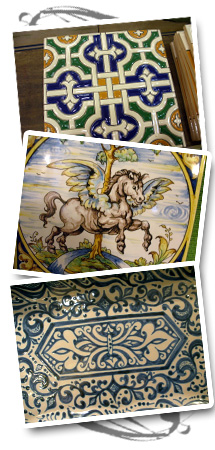
Ceramic styles
Mudejar School
It is in this capital where, without doubt, the Mudejar maintained a highly singular presence thanks to the Muslim population which, throughout all of the Early Middle Ages, remained in the Imperial City. Their style, influenced by their culture, is recognised in the abundance of geometric patterns and drawings. Different colours and compositions characterise such work.
- XIV CENTURY
We find a number of styles of decoration, the most classic being in blue and white, although those executed in several colours are equally traditional.
Puente del Arzobispo School
This town in the province of Toledo is characterised by the recognised quality of its clay, which we are able to say is used by the majority of craftsmen throughout the country.
We can find different styles within each school, which we will denominate as follows:
- XV CENTURY
The most usual motifs are those produced in blue and whose drawings are usually decorated with animals such as: birds, partridges; deer; rabbits, hares etc… - XVI CENTURY
In the same way as the above, the drawings or patterns are repeated, the difference being the colour, of which red is the most common. - XVII CENTURY
Seemingly the most recognised, with green as the basic colour along with other colours, and in whose decoration, along with the above-mentioned animals, we find a joyful, colourful style produced with fruits such as: Oranges, lemons, grapes, cherries, etc…
Talavera School
Possibly the most artistic of all, in whose products we can find different influences.
XVIII CENTURY - Within this epoch we can distinguish different styles:
- Floral motifs
Different floral compositions adorn the pieces, all of them equally traditional but with very distinct motifs and colouring. - Hunting motifs
These decorative compositions are characterised by the variety of animals that adorn the pieces, such as rabbits, deer, partridges, foxes, dogs, etc… accompanied by landscapes which evoke scenes of hunting and woodlands.
Also very typical are scenes of the hidalgo Don Quixote De La Mancha and his companion Sancho in typical Toledo surroundings, such as The Windmills. - Renaissance motifs
These are some of the most meticulously detailed works in terms of their decoration. The combinations of blue and yellow stand out, with intertwined fretwork fully adorning the products.

